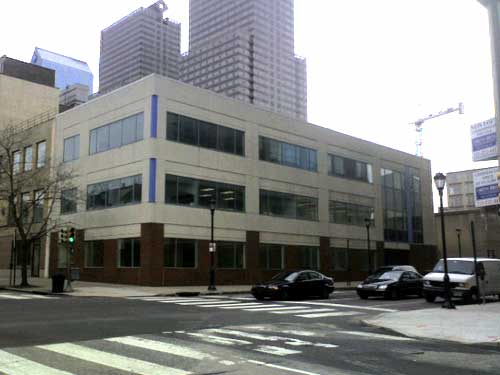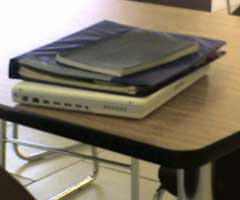 |
| Science Leadership Academy, Philadelphia |
Yesterday, I visited a school that is brand new in almost any way that you can imagine, and in many ways you probably couldn’t. Led by Chris Lehmann, the Science Leadership Academy is a new school (approximately five months) in inner-city Philadelphia. It is also one of the only schools that is explicitly labeling itself and putting into practice School 2.0 — a conversation I would like to have had more of yesterday. Evidence of this conversation was everywhere and by every stakeholder (the parents have their own room).
It is a 1:1 school. All the students carried bookbags, but in most cases they were empty except for a Macintosh iBook (or were they MacBooks — I’ve lost track). In the classroom, these computers are open more than they are closed. Teachers are directing students in work, not in listening. The computers are not talked about very much, perhaps only a little more than pencils are talked about in traditional classrooms, and this is a good thing. I suspect that five months from now, they’ll be talked about even less.
 |
| Contents of an SLA Bookbag |
 |
| A laptop with water colors. Eggads! |
 |
| A sign of things to come! |
..and this is what I look forward to now — revisiting this school in five more months. What I saw yesterday was a school that is looking for pavement, and it’s exciting. You see, this is a school that has opened up. It’s opened up its curriculum, its resources, its pedagogy, its schedule, and even more importantly, its avenues for communication, using the latest in Web 2.0 applications (Moodle, elgg, del.icio.us, blogging, podcasting, and others that I heard mention of yesterday). Their challenge is that these 14 and 15 year old students are finding themselves floating in this open environment along with teachers who are mostly coming from traditional schools. But I saw students and teachers desperately and skillfully trying to find and define the new boundaries that these new avenues avail and to use those boundaries for traction.
The word that I most often think of to describe school 2.0 is conversations. In old school, conversation usually goes in one direction. From teacher to student, from textbook to student, from worksheet to student, and the student responds through tests and essays. In School 2.0 the conversations are alive and they flow in almost any direction. I heard reference more than once yesterday to a new conversation between the school and the community, and students are becoming responsible for much of that conversation.
But this is an enormous challenge, and the word that I couldn’t think of yesterday that I think best describes their challenge is channel. They are trying to re-channel learning through a learning environment that is no longer a shoebox, but a vibrant network of conversations that are spoken, written, and drawn, tagged, posted, read, built-on, responded to, and re-tagged and posted again. Those of you who are practiced in Web 2.0 applications know what all of this implies — learning through conversation and crafting classrooms that can channel that conversation in potent ways.
Today, I visit one of the oldest schools in North American, a school that first opened its doors to learners in the 17th century. I’m sure I’ll have more to say tomorrow — when I’ll be back home for a few days.

Wow! That is all I can say. This is the school that Rip van Winkle would not recognize. I am in a relatively new school (5 years old) and I have had a computer station in my class since the school opened and not one computer yet. I am green with envy.
I transferred out to Countesthorpe Community College when I was 13, a state school in the county of Leicestershire, UK, that took UK high school and sixth form students (13-19 years old). The school had a very progressive heritage – and I’m disappointed that it is hard to find very much evidence of its inception & activity online – here’s a paragraph I did eventually find:
“…a rather sketchy account by Bernbaum (1973) of Countesthorpe College. Countesthorpe was started from scratch as an innovative enterprise. The planning was based on the idea that ‘the opportunity is being offered by the foundation of the new school to rethink the total process of learning within the school . . . “it should mean that we do not automatically repeat an established practice without considering why†’. The building is radical, the school ‘attracts teachers who are especially committed to change and innovation’, the head was specially chosen with this in mind. Bernbaum comments: ‘a variety of new ideas has been put into practice at Countesthorpe. Each on its own is probably not totally novel, though the accumulation of innovation in one school most certainly is.’ 
In short, Countesthorpe is in a sense an experimental school and perhaps the first radically experimental school in the state system.â€
I can remember how important to me at the time as a young student the knowledge of the institutions commitment to learners and to rethinking the process of learning according to our needs and interests was. I was lucky enough to attend the school the end of it’s radical approach to learning: I still have hugely fond memories towards many of the faculty who, in stark contrast to my previous state school, treated me as a person capable of thought and commitment. I also remember how impressed I was with the college architecture, and how the building had been designed around communities of learning – with familiar and common spaces, as opposed to the constant migration from one room and group to another. The democracy of having no staff room was and remains a wonder to me.
Anyway – thank you for highlighting this new school. I guess what I’m trying to express is my thanks to my old school for being progressive, reactive to the needs of pupils and happy to experiment with new ideas and methods – precisely what I most identify with in the sketch you’ve drawn of this school. The technology is great, but it’s actually only what I would expect from an institution in tune with its learners and with its learners experience.
wow, sounds great.
do you know if the teachers volunteered to teach there, or were assigned? same with the students, were they hand selected or ‘first come first served’ or go there because it is their neighborhood school?
Jeff,
In both cases, the answer is neither. The teachers were interviewed and hired by the principal, and I suspect a committee. One teacher told me that it appeared that Chris, the principal, was asking questions and presenting scenarios, not so much to judge their answers, but that he was looking for sparkle, a sparkle to appear in their eyes. Well that sounds a bit corny, but I suspect he was looking for teachers who would love working in this kind of school.
As for the students, they, too, apply, are interviewed, and must be accepted. Now the instant response is, “Oh! Well! No wonder! If I could select my own students, then watch me go…” But sitting in on these classes, I didn’t see a student body who was selected to me their job easy. On the contrary, I saw students who were demanding to be taught important things well. They looked for students who, regardless of past performance, they believed would prosper in an more open and challenging environment. They’ve got plenty of problem kids — and I know problem kids. I saw them. But these children were always talked about in terms of their potential.
I’m not sure if they were able to implement it this year, but one model SLA will be following is to have existing students on the interview committee to interview potential students.
I hope that I have a chance to return near the end of this school year.
Josie — couldn’t agree more!
David — yep. We were able to implement that this year, and it was an incredible experience. Kids interviewed along side teachers. They ran the writing prompt rooms, they tallked to parents while the parents waited for their kids. And they helped us plan and implement the whole process. It was incredible.
The biggest challenge we face, I think, is taking the students’ desire to learn in new ways and then helping them be able to do it. By contrast, Beacon (in NYC) draws a significant portion of its population from very progressive middle schools, and therefore, there is a big part of the population that is coming to an environment that, while more rigorous, is a learning style they are used to. There is not as much of that pedagogy in Philly, therefore, we have a great many kids for whom this kind of learning is a HUGE adjustment. Add the technological aspects of what we’re doing, and these kids are dealing with a lot of change. (To say nothing of the adults!) But the kids believe in what we’re doing, and they are growing every day.
We’d love to have you back this year! It’s an open invite, come any time!
I was in the first year intake to Countesthorpe College. If you guys want more info, jest email me